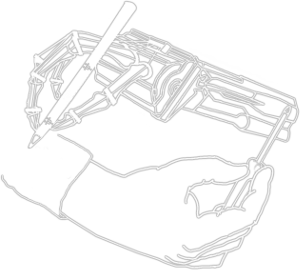Export 34 results:
Author [ Title ] Type Year
] Type Year Filters: First Letter Of Last Name is M [Clear All Filters]
Using a System-Based Monitoring Paradigm to Assess Fatigue during Submaximal Static Exercise of the Elbow Extensor Muscles. Sensors (2021).
Understanding variable moment arms for the index finger MCP joints through the ACT hand. Biomedical Robotics and Biomechatronics, 2008. BioRob 2008. 2nd IEEE RAS & EMBS International Conference on 776–782 (IEEE, 2008).
Quantifying Changes in Kinematic Behavior of a Human-Exoskeleton Interactive System. 2022 IEEE/RSJ International Conference on Intelligent Robots and Systems (IROS) (2022). doi:10.1109/IROS47612.2022.9981032
A Novel Control Law for Multi-Joint Human-Robot Interaction Tasks While Maintaining Postural Coordination. 2023 IEEE/RSJ International Conference on Intelligent Robots and Systems (IROS) (2023). doi:10.1109/IROS55552.2023.10342501
Monitoring Human Neuromusculoskeletal System Performance during Spacesuit Glove Use: A Pilot Study. IEEE Aerospace Conference (2018).
Monitoring Fatigue-Induced Changes in Performance during Robot-Mediated Dynamic Movement. IEEE International Conference on Robotics and Automation (ICRA) (2021).
Methodologies for determining minimal grasping requirements and sensor locations for sEMG-based assistive hand orthosis for SCI patients. IEEE International Conference of Rehabilitation Robotics (ICORR) (2017).
Mechanisms of the anatomically correct testbed hand. Mechatronics, IEEE/ASME Transactions on 18, 238–250 (2013).
Kinematic coordinations capture learning during human-exoskeleton interaction. Scientific Reports 13, (2023).
On Integration of Additive Manufacturing During the Design and Development of a Rehabilitation Robot: A Case Study. Journal of Mechanical Design (2015).
The Influence of Robotic Assistance on Reducing Neuromuscular Effort and Fatigue during Extravehicular Activity Glove Use. International Conference on Environmental Systems (ICES) (2017).
The Influence of Robotic Assistance on Reducing Neuromuscular Effort and Fatigue during Extravehicular Activity Glove Use. International Conference on Environmental Systems (ICES) (2017).
Improvement of Hand Functions of SCI Patients with EMG-driven Hand Exoskeleton: a Feasibility Study. Wearable Technologies (2021).
Experimental and Simulation-Based Estimation of Interface Power During Physical Human-Robot Interaction in Hand Exoskeletons. IEEE Robotics and Automation Letters 9, 2575-2581 (2024).
An EMG-Driven Assistive Hand Exoskeleton for Spinal Cord Injury Patients: Maestro. IEEE International Conference on Robotics and Automation (ICRA) (2017).
The Human Hand as an Inspiration for Robot Hand Development 453–475 (Springer, 2014).
Designing Variable Stiffness Profiles To Optimize The Physical Human Robot Interface Of Hand Exoskeletons. BioRob (IEEE International Conference on Biomedical Robotics and Biomechatronics) (2018).
Designing Physical Human-Robot Interaction Interfaces: A Scalable Method for Simulation Based Design. Frontiers in Neurorobotics (2022).
Design, Control and Testing of a Thumb Exoskeleton with Series Elastic Actuation. International Journal of Robotics Research (2017).
Crocheted Artificial Tendons and Ligaments for the Anatomically Correct Testbed (ACT) Hand. IEEE ROBIO (2015).
Control strategies for the index finger of a tendon-driven hand. The International Journal of Robotics Research 32, 115–128 (2013).
Contributions of intrinsic visco-elastic torques during planar index finger and wrist movements. Biomedical Engineering, IEEE Transactions on 59, 586–594 (2012).
Characterizing the Onset and Offset of Motor Imagery During Passive Arm Movements Induced by an Upper-Body Exoskeleton. 2023 IEEE/RSJ International Conference on Intelligent Robots and Systems (IROS) (2023). doi:10.1109/IROS55552.2023.10342492
Characterizing the Onset and Offset of Motor Imagery During Passive Arm Movements Induced by an Upper-Body Exoskeleton. 2023 IEEE/RSJ International Conference on Intelligent Robots and Systems (IROS) (2023). doi:10.1109/IROS55552.2023.10342492
Characterization of a hand-wrist exoskeleton, READAPT, via kinematic analysis of redundant pointing tasks. Rehabilitation Robotics (ICORR), 2015 IEEE International Conference on 205–210 (IEEE, 2015).
Is the Cerebellum a Model-Based Reinforcement Learning Agent?. Adaptive and Learning Agents (ALA) Workshop at the International Conference on Autonomous Agents and Multiagent Systems (2021).
Is the Cerebellum a Model-Based Reinforcement Learning Agent?. Adaptive and Learning Agents (ALA) Workshop at the International Conference on Autonomous Agents and Multiagent Systems (2021).
Is the Cerebellum a Model-Based Reinforcement Learning Agent?. Adaptive and Learning Agents (ALA) Workshop at the International Conference on Autonomous Agents and Multiagent Systems (2021).
Capturing Skill State in Curriculum Learning for Human Skill Acquisition. 2021 IEEE/RSJ International Conference on Intelligent Robots and Systems (IROS 2021) (2021).
Capturing Skill State in Curriculum Learning for Human Skill Acquisition. 2021 IEEE/RSJ International Conference on Intelligent Robots and Systems (IROS 2021) (2021).
ACT hand finger control: muscle and joint torque control strategies. IEEE International Conference on Robotics and Automation (2009).
Acquiring variable moment arms for index finger using a robotic testbed. Biomedical Engineering, IEEE Transactions on 57, 2034–2044 (2010).
Accurate Torque Control of Finger Joints with UT Hand Exoskeleton through Bowden Cable SEA. IEEE International Conference on Robotics and Automation (IROS) (2016).

